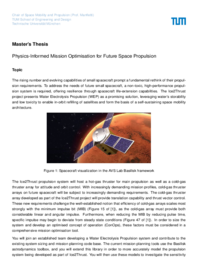Physics-Informed Mission Optimisation for Future Space Propulsion
- Institut
- Lehrstuhl für Raumfahrtantriebe
- Typ
- Masterarbeit
- Inhalt
- Beschreibung
The rising number and evolving capabilities of small spacecraft prompt a fundamental rethink of their propulsion requirements. To address the needs of future small spacecraft, a non-toxic, high-performance propulsion system is required, offering resilience through spacecraft life-extension capabilities. The Ice2Thrust project presents Water Electrolysis Propulsion (WEP) as a promising solution, leveraging water’s storability and low toxicity to enable in-orbit refilling of satellites and form the basis of a self-sustaining space mobility architecture.
The Ice2Thrust propulsion system will host a hot-gas thruster for main propulsion as well as a cold-gas thruster array for attitude and orbit control. With increasingly demanding mission profiles, cold-gas thruster arrays on future spacecraft will be subject to increasingly demanding requirements. The cold-gas thruster array developed as part of the Ice2Thrust project will provide translation capability and thrust vector control. These new requirements challenge the well-established notion that efficiency of cold-gas arrays scales most strongly with the minimum impulse bit (MIB), as the cold-gas array must provide both considerable linear and angular impulse. Furthermore, when reducing the MIB by reducing pulse time, specific impulse may begin to deviate from steady state conditions. In order to size the system and develop an optimised concept of operation (ConOps), these factors must be considered in a comprehensive mission optimisation tool.
You will join an established team developing a Water Electrolysis Propulsion system and contribute to the existing system sizing and mission planning code base. The current mission planning tools use the Basilisk astrodynamics toolbox, and you will extend this library in order to more accurately model the propulsion system being developed as part of Ice2Thrust. You will then use these models to investigate the sensitivity of the added parameters on overall system performance and develop a strong understanding of the trade-offs involved in spacecraft design.
Tasks
- Implementation and validation of physics-informed models, including:
- Drag-induced angular impulse
- Transient thruster operation
- Intelligent bi-propellant cold-gas array operation
- Propellant generation by an electrolyser
- Assessment of propellant needs by the cold-gas array for several sample missions.
- Determination of an optimal operational envelope for exclusively cold-gas attitude control.
- Sensitivity analysis of propellant use, considering attitude control system performance parameters including:
- Specific Impulse
- Minimum Impulse Bit
- Transient thruster performance
- Documentation and presentation of results.
- Implementation and validation of physics-informed models, including:
- Voraussetzungen
- Student in Informatics, Aerospace or Mechanical Engineering.
- Interested in simulation methods.
- Knowledge of Python highly desirable.
- Experience with object-oriented programming a bonus.
- Möglicher Beginn
- sofort
- Kontakt
-
Tomas Mrazek, M.Eng.
Tel.: +33695349960
tomas.mrazektum.de - Ausschreibung
-
